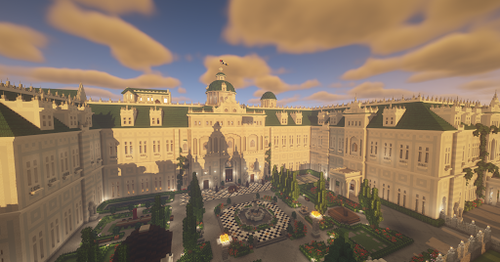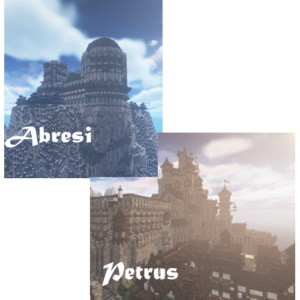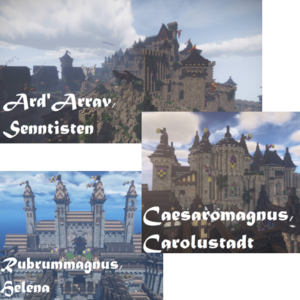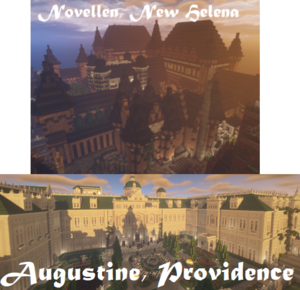The Court of Oren
| ||||||||||||||||||||||||||||||||
The Court of Oren is the standing system of courtiers and councilors that reside within the imperial palace of the Holy Orenian Empire beside the ruling house, currently the House of Novellen. The imperial court is a vital part of Orenian society and has been for centuries, being a hotspot of cultural enterprise and the upkeep of high society. However, it is also a point of great controversy and criticism since the Dawn of Oren as a result of the pomp and exclusivity exuded as a place of strict hierarchy between noble and commoner that is rivaled by little other courts. A strong court has been an integral part of a strong government since the times of the Horen Restoration, when the palace morphed into a center of activity, and a performance of power and unity. Throughout orenian history, there have been countless court reformations, declines, scandals and etc, that have happened in the courts, with more recent periods seeing a stagnancy in the functions of court positions.
Notable courts include that of John III and his consort Julia of Furnestock's, which is a court that holds remembrance in history for its exhibitions of art and power. Another would be that of the Emperor of Man, Augustus and his consort Helen of Carolustadt's, with the presence of Maria Viktoria of Krajia, a beloved socialite who molded the courts and fashions of Renatus at her will.
Contents
Present Day; The Augustine Court
The Imperial Augustine Palace, originally constructed by famous architect John Henry, Prince of Pruvia, though it often undergoes renovations with the interior and exterior, the most popular of which being the installation of a garden by HIH the Count of Aldersberg, Joseph Leopold. Serving as the home of His Imperial Majesty and his family as well as the many noble courtiers he so graciously offers housing to, the palace is the crown jewel of Providence. Most importantly within the Augustine is His Majesty’s many courtiers, and staff that certainly keep the palace moving as it always has in allowing for a mark to be made on the Empire as a whole from within the pristine walls of the palace.
Court System
In 1837, the following roles were outlined in a document approved by HIM John VIII. See: [4]
Governor of the Augustine The Governor is the head of the Imperial Courts, and serves at the discretion of the Crown. They direct the management of the Courts, and assure that the necessary functions of the Imperial Household are executed and held to the highest standard. In the case wherein any of the management positions are not occupied, or are not operating to their full capacity, it is the duty of the Governor to assure these departments are maintained. The Governor also nominates members of the court management of the to the Emperor, for final approval by His Imperial Majesty.
Majordomo of the Augustine The Majordomo serves as a second in command to the Governor and acts in full capacity in the absence of a Governor. She may be assigned to various projects by the Governor or take a more general role within the events of the palace. She assists the Governor in whatever they may ask, whether it be events or simply management in general.
Lord Seneschal The Lord Seneschal directs all employees of the Imperial Palace. These laborers may include servants, butlers, musicians, physicians, etc. They organize and provide services for the Courtiers during both events and daily life. It is the responsibility of the Lord Seneschal to ensure that laborers of their department are trained in both etiquette and efficient service. They are also charged with directing and employing tutors of the courts, and assuring the next generation is properly educated in the legacy, culture, and knowledge of the Empire.
Master of the Keys The Master of the Keys manages the apartments within the Imperial Courts, as well as all the locks within the Palace. He assures that only those most qualified Orenians may access the various parts of the Palace, and maintains a set of standards for those entitled to an apartment.
Captain of the Fourth Brigade The Captain of the Fourth brigade serves as the de facto Chief of Security within the Palace, and is appointed at the discretion of the General of the Imperial State Army. He is responsible for assuring the safety of the Courtiers and the Imperial family, as well as organizing security for those highest ranking Orenians during events. In cases wherein the safety of the Courtiers, Oregonian Officials, and members of the Imperial family is immediately threatened, the Captain of the Fourth may assume executive authority over the Courts, in order to assure their ongoing safety and protection.
Director of the Event Committee The director of the Imperial Event Committee serves as the president of the Event Committee. They are in charge of administering and providing resources for state sponsored events both within the courts and throughout the empire. They direct the committee and assure both the economic and cultural growth of the Empire, through their events.
Fashion Fads
Notable Socialites
Public Perception
Controversy and Scandal
| Historical Courts of Oren | ||||||||||||||||||||||||||||||||
|---|---|---|---|---|---|---|---|---|---|---|---|---|---|---|---|---|---|---|---|---|---|---|---|---|---|---|---|---|---|---|---|---|
Historical CourtsEarly Renation
Information about early oren. SPAM SPAM SPAM SPAM SPAM SPAM SPAM SPAM SPAM SPAM SPAM SPAM SPAM SPAM SPAM SPAM SPAM SPAM SPAM SPAM SPAM SPAM SPAM SPAM SPAM SPAM SPAM SPAM SPAM SPAM SPAM SPAM SPAM SPAM SPAM SPAM SPAM SPAM SPAM SPAM SPAM SPAM SPAM SPAM SPAM SPAM SPAM SPAM SPAM SPAM SPAM SPAM SPAM SPAM SPAM SPAM SPAM SPAM SPAM SPAM SPAM SPAM SPAM SPAM SPAM SPAM SPAM SPAM SPAM SPAM SPAM SPAM SPAM SPAM SPAM SPAM SPAM SPAM SPAM SPAM SPAM SPAM SPAM SPAM SPAM SPAM SPAM SPAM SPAM SPAM SPAM SPAM SPAM SPAM SPAM SPAM SPAM SPAM SPAM SPAM SPAM SPAM SPAM SPAM SPAM SPAM SPAM SPAM SPAM SPAM SPAM SPAM SPAM SPAM SPAM SPAM SPAM SPAM SPAM SPAM SPAM SPAM SPAM SPAM SPAM SPAM SPAM SPAM SPAM SPAM SPAM SPAM SPAM SPAM SPAM SPAM SPAM SPAM SPAM SPAM SPAM SPAM SPAM SPAM SPAM SPAM SPAM SPAM SPAM SPAM SPAM SPAM SPAM SPAM SPAM SPAM SPAM SPAM SPAM SPAM SPAM SPAM SPAM SPAM SPAM SPAM SPAM SPAM SPAM SPAM SPAM SPAM SPAM SPAM SPAM SPAM SPAM SPAM SPAM SPAM SPAM SPAM SPAM SPAM SPAM SPAM SPAM SPAM SPAM SPAM SPAM SPAM SPAM SPAM SPAM SPAM SPAM SPAM SPAM SPAM SPAM SPAM SPAM SPAM SPAM SPAM SPAM SPAM SPAM SPAM SPAM SPAM SPAM SPAM SPAM SPAM SPAM SPAM SPAM SPAM SPAM SPAM SPAM SPAM SPAM SPAM SPAM SPAM SPAM SPAM SPAM SPAM SPAM SPAM SPAM SPAM SPAM SPAM SPAM SPAM SPAM SPAM SPAM SPAM SPAM SPAM SPAM SPAM SPAM SPAM SPAM SPAM SPAM SPAM SPAM SPAM SPAM SPAM SPAM SPAM SPAM SPAM SPAM SPAM SPAM SPAM SPAM SPAM SPAM SPAM SPAM SPAM SPAM SPAM SPAM SPAM SPAM SPAM SPAM SPAM SPAM SPAM SPAM SPAM SPAM SPAM SPAM SPAM SPAM SPAM SPAM SPAM SPAM SPAM SPAM SPAM SPAM SPAM SPAM SPAM SPAM SPAM SPAM SPAM SPAM SPAM SPAM SPAM SPAM SPAM SPAM SPAM SPAM SPAM SPAM SPAM SPAM SPAM SPAM SPAM SPAM SPAM SPAM SPAM SPAM SPAM SPAM SPAM SPAM SPAM SPAM SPAM SPAM SPAM SPAM SPAM SPAM SPAM SPAM SPAM SPAM SPAM SPAM SPAM SPAM SPAM SPAM SPAM SPAM SPAM SPAM SPAM SPAM SPAM SPAM SPAM SPAM SPAM SPAM SPAM SPAM SPAM SPAM SPAM SPAM SPAM SPAM SPAM SPAM SPAM SPAM SPAM SPAM SPAM SPAM SPAM SPAM SPAM SPAM SPAM SPAM SPAM SPAM SPAM SPAM SPAM SPAM SPAM SPAM SPAM SPAM SPAM SPAM SPAM SPAM SPAM SPAM SPAM SPAM SPAM SPAM SPAM SPAM SPAM SPAM SPAM SPAM SPAM SPAM SPAM SPAM SPAM SPAM SPAM SPAM SPAM SPAM SPAM SPAM SPAM SPAM SPAM SPAM SPAM SPAM SPAM SPAM SPAM SPAM SPAM SPAM SPAM SPAM SPAM SPAM SPAM SPAM SPAM SPAM SPAM SPAM SPAM SPAM SPAM SPAM SPAM SPAM SPAM SPAM SPAM SPAM SPAM SPAM SPAM SPAM SPAM SPAM SPAM SPAM SPAM SPAM SPAM SPAM SPAM SPAM SPAM SPAM SPAM SPAM SPAM SPAM SPAM SPAM SPAM SPAM SPAM SPAM SPAM SPAM SPAM SPAM SPAM SPAM SPAM SPAM SPAM SPAM SPAM SPAM SPAM SPAM SPAM SPAM SPAM SPAM SPAM SPAM SPAM SPAM SPAM SPAM SPAM SPAM SPAM SPAM SPAM SPAM SPAM Horen Restoration
Information about the courts of the Horen restoration. SPAM SPAM SPAM SPAM SPAM SPAM SPAM SPAM SPAM SPAM SPAM SPAM SPAM SPAM SPAM SPAM SPAM SPAM SPAM SPAM SPAM SPAM SPAM SPAM SPAM SPAM SPAM SPAM SPAM SPAM SPAM SPAM SPAM SPAM SPAM SPAM SPAM SPAM SPAM SPAM SPAM SPAM SPAM SPAM SPAM SPAM SPAM SPAM SPAM SPAM SPAM SPAM SPAM SPAM SPAM SPAM SPAM SPAM SPAM SPAM SPAM SPAM SPAM SPAM SPAM SPAM SPAM SPAM SPAM SPAM SPAM SPAM SPAM SPAM SPAM SPAM SPAM SPAM SPAM SPAM SPAM SPAM SPAM SPAM SPAM SPAM SPAM SPAM SPAM SPAM SPAM SPAM SPAM SPAM SPAM SPAM SPAM SPAM SPAM SPAM SPAM SPAM SPAM SPAM SPAM SPAM SPAM SPAM SPAM SPAM SPAM SPAM SPAM SPAM SPAM SPAM SPAM SPAM SPAM SPAM SPAM SPAM SPAM SPAM SPAM SPAM SPAM SPAM SPAM SPAM SPAM SPAM SPAM SPAM SPAM SPAM SPAM SPAM SPAM SPAM SPAM SPAM SPAM SPAM SPAM SPAM SPAM SPAM SPAM SPAM SPAM SPAM SPAM SPAM SPAM SPAM SPAM SPAM SPAM SPAM SPAM SPAM SPAM SPAM SPAM SPAM SPAM SPAM SPAM SPAM SPAM SPAM SPAM SPAM SPAM SPAM SPAM SPAM SPAM SPAM SPAM SPAM SPAM SPAM SPAM SPAM SPAM SPAM SPAM SPAM SPAM SPAM SPAM SPAM SPAM SPAM SPAM SPAM SPAM SPAM SPAM SPAM SPAM SPAM SPAM SPAM SPAM SPAM SPAM SPAM SPAM SPAM SPAM SPAM SPAM SPAM SPAM SPAM SPAM SPAM SPAM SPAM SPAM SPAM SPAM SPAM SPAM SPAM SPAM SPAM SPAM SPAM SPAM SPAM SPAM SPAM SPAM SPAM SPAM SPAM SPAM SPAM SPAM SPAM SPAM SPAM SPAM SPAM SPAM SPAM SPAM SPAM SPAM SPAM SPAM SPAM SPAM SPAM SPAM SPAM SPAM SPAM SPAM SPAM SPAM SPAM SPAM SPAM SPAM SPAM SPAM SPAM SPAM SPAM SPAM SPAM SPAM SPAM SPAM SPAM SPAM SPAM SPAM SPAM SPAM SPAM SPAM SPAM SPAM SPAM SPAM SPAM SPAM SPAM SPAM SPAM SPAM SPAM SPAM SPAM SPAM SPAM SPAM SPAM SPAM SPAM SPAM SPAM SPAM SPAM SPAM SPAM SPAM SPAM SPAM SPAM SPAM SPAM SPAM SPAM SPAM SPAM SPAM SPAM SPAM SPAM SPAM SPAM SPAM SPAM SPAM SPAM SPAM SPAM SPAM SPAM SPAM SPAM SPAM SPAM SPAM SPAM SPAM SPAM SPAM SPAM SPAM SPAM SPAM SPAM SPAM SPAM SPAM SPAM SPAM SPAM SPAM SPAM SPAM SPAM SPAM SPAM SPAM SPAM SPAM SPAM SPAM SPAM SPAM SPAM SPAM SPAM SPAM SPAM SPAM SPAM SPAM SPAM SPAM SPAM SPAM SPAM SPAM SPAM SPAM SPAM SPAM SPAM SPAM SPAM SPAM SPAM SPAM SPAM SPAM SPAM SPAM SPAM SPAM SPAM SPAM SPAM SPAM SPAM SPAM SPAM SPAM SPAM SPAM SPAM SPAM SPAM SPAM SPAM SPAM SPAM SPAM SPAM SPAM SPAM SPAM SPAM SPAM SPAM SPAM SPAM SPAM SPAM SPAM SPAM SPAM SPAM SPAM SPAM SPAM SPAM SPAM SPAM SPAM SPAM SPAM SPAM SPAM SPAM SPAM SPAM SPAM SPAM SPAM SPAM SPAM SPAM SPAM SPAM SPAM SPAM SPAM SPAM SPAM SPAM SPAM SPAM SPAM SPAM SPAM SPAM SPAM SPAM SPAM SPAM SPAM SPAM SPAM SPAM SPAM SPAM SPAM SPAM SPAM SPAM SPAM SPAM SPAM SPAM SPAM SPAM SPAM SPAM SPAM SPAM SPAM SPAM SPAM SPAM SPAM SPAM SPAM SPAM SPAM SPAM SPAM SPAM SPAM Empires of Man & Renatus
Information about the courts of the Empires of Man & Renatus. SPAM SPAM SPAM SPAM SPAM SPAM SPAM SPAM SPAM SPAM SPAM SPAM SPAM SPAM SPAM SPAM SPAM SPAM SPAM SPAM SPAM SPAM SPAM SPAM SPAM SPAM SPAM SPAM SPAM SPAM SPAM SPAM SPAM SPAM SPAM SPAM SPAM SPAM SPAM SPAM SPAM SPAM SPAM SPAM SPAM SPAM SPAM SPAM SPAM SPAM SPAM SPAM SPAM SPAM SPAM SPAM SPAM SPAM SPAM SPAM SPAM SPAM SPAM SPAM SPAM SPAM SPAM SPAM SPAM SPAM SPAM SPAM SPAM SPAM SPAM SPAM SPAM SPAM SPAM SPAM SPAM SPAM SPAM SPAM SPAM SPAM SPAM SPAM SPAM SPAM SPAM SPAM SPAM SPAM SPAM SPAM SPAM SPAM SPAM SPAM SPAM SPAM SPAM SPAM SPAM SPAM SPAM SPAM SPAM SPAM SPAM SPAM SPAM SPAM SPAM SPAM SPAM SPAM SPAM SPAM SPAM SPAM SPAM SPAM SPAM SPAM SPAM SPAM SPAM SPAM SPAM SPAM SPAM SPAM SPAM SPAM SPAM SPAM SPAM SPAM SPAM SPAM SPAM SPAM SPAM SPAM SPAM SPAM SPAM SPAM SPAM SPAM SPAM SPAM SPAM SPAM SPAM SPAM SPAM SPAM SPAM SPAM SPAM SPAM SPAM SPAM SPAM SPAM SPAM SPAM SPAM SPAM SPAM SPAM SPAM SPAM SPAM SPAM SPAM SPAM SPAM SPAM SPAM SPAM SPAM SPAM SPAM SPAM SPAM SPAM SPAM SPAM SPAM SPAM SPAM SPAM SPAM SPAM SPAM SPAM SPAM SPAM SPAM SPAM SPAM SPAM SPAM SPAM SPAM SPAM SPAM SPAM SPAM SPAM SPAM SPAM SPAM SPAM SPAM SPAM SPAM SPAM SPAM SPAM SPAM SPAM SPAM SPAM SPAM SPAM SPAM SPAM SPAM SPAM SPAM SPAM SPAM SPAM SPAM SPAM SPAM SPAM SPAM SPAM SPAM SPAM SPAM SPAM SPAM SPAM SPAM SPAM SPAM SPAM SPAM SPAM SPAM SPAM SPAM SPAM SPAM SPAM SPAM SPAM SPAM SPAM SPAM SPAM SPAM SPAM SPAM SPAM SPAM SPAM SPAM SPAM SPAM SPAM SPAM SPAM SPAM SPAM SPAM SPAM SPAM SPAM SPAM SPAM SPAM SPAM SPAM SPAM SPAM SPAM SPAM SPAM SPAM SPAM SPAM SPAM SPAM SPAM SPAM SPAM SPAM SPAM SPAM SPAM SPAM SPAM SPAM SPAM SPAM SPAM SPAM SPAM SPAM SPAM SPAM SPAM SPAM SPAM SPAM SPAM SPAM SPAM SPAM SPAM SPAM SPAM SPAM SPAM SPAM SPAM SPAM SPAM SPAM SPAM SPAM SPAM SPAM SPAM SPAM SPAM SPAM SPAM SPAM SPAM SPAM SPAM SPAM SPAM SPAM SPAM SPAM SPAM SPAM SPAM SPAM SPAM SPAM SPAM SPAM SPAM SPAM SPAM SPAM SPAM SPAM SPAM SPAM SPAM SPAM SPAM SPAM SPAM SPAM SPAM SPAM SPAM SPAM SPAM SPAM SPAM SPAM SPAM SPAM SPAM SPAM SPAM SPAM SPAM SPAM SPAM SPAM SPAM SPAM SPAM SPAM SPAM SPAM SPAM SPAM SPAM SPAM SPAM SPAM SPAM SPAM SPAM SPAM SPAM SPAM SPAM SPAM SPAM SPAM SPAM SPAM SPAM SPAM SPAM SPAM SPAM SPAM SPAM SPAM SPAM SPAM SPAM SPAM SPAM SPAM SPAM SPAM SPAM SPAM SPAM SPAM SPAM SPAM SPAM SPAM SPAM SPAM SPAM SPAM SPAM SPAM SPAM SPAM SPAM SPAM SPAM SPAM SPAM SPAM SPAM SPAM SPAM SPAM SPAM SPAM SPAM SPAM SPAM SPAM SPAM SPAM SPAM SPAM SPAM SPAM SPAM SPAM SPAM SPAM SPAM SPAM SPAM SPAM SPAM SPAM SPAM SPAM SPAM SPAM SPAM SPAM SPAM SPAM SPAM SPAM SPAM SPAM SPAM SPAM SPAM SPAM SPAM SPAM SPAM SPAM SPAM SPAM SPAM SPAM SPAM The Petrine Revival
Information about the courts of the Empire during the Year of Four Emperors. SPAM SPAM SPAM SPAM SPAM SPAM SPAM SPAM SPAM SPAM SPAM SPAM SPAM SPAM SPAM SPAM SPAM SPAM SPAM SPAM SPAM SPAM SPAM SPAM SPAM SPAM SPAM SPAM SPAM SPAM SPAM SPAM SPAM SPAM SPAM SPAM SPAM SPAM SPAM SPAM SPAM SPAM SPAM SPAM SPAM SPAM SPAM SPAM SPAM SPAM SPAM SPAM SPAM SPAM SPAM SPAM SPAM SPAM SPAM SPAM SPAM SPAM SPAM SPAM SPAM SPAM SPAM SPAM SPAM SPAM SPAM SPAM SPAM SPAM SPAM SPAM SPAM SPAM SPAM SPAM SPAM SPAM SPAM SPAM SPAM SPAM SPAM SPAM SPAM SPAM SPAM SPAM SPAM SPAM SPAM SPAM SPAM SPAM SPAM SPAM SPAM SPAM SPAM SPAM SPAM SPAM SPAM SPAM SPAM SPAM SPAM SPAM SPAM SPAM SPAM SPAM SPAM SPAM SPAM SPAM SPAM SPAM SPAM SPAM SPAM SPAM SPAM SPAM SPAM SPAM SPAM SPAM SPAM SPAM SPAM SPAM SPAM SPAM SPAM SPAM SPAM SPAM SPAM SPAM SPAM SPAM SPAM SPAM SPAM SPAM SPAM SPAM SPAM SPAM SPAM SPAM SPAM SPAM SPAM SPAM SPAM SPAM SPAM SPAM SPAM SPAM SPAM SPAM SPAM SPAM SPAM SPAM SPAM SPAM SPAM SPAM SPAM SPAM SPAM SPAM SPAM SPAM SPAM SPAM SPAM SPAM SPAM SPAM SPAM SPAM SPAM SPAM SPAM SPAM SPAM SPAM SPAM SPAM }}</center>
|




